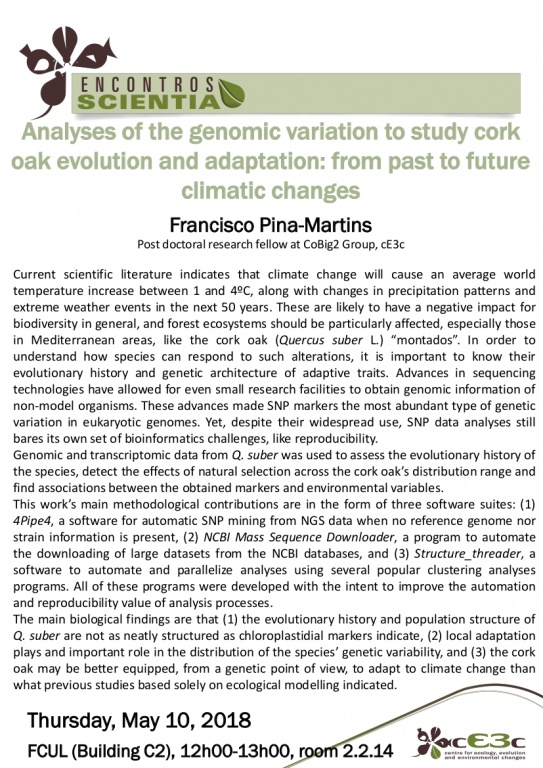Analyses of the genomic variation to study cork oak evolution and adaptation: from past to future climatic changes
Francisco Pina-Martins
Post-Doc Researcher at Cobig2-cE3c
Current scientific literature indicates that climate change will cause an average world temperature increase between 1 and 4ºC, along with changes in precipitation patterns and extreme weather events in the next 50 years. These are likely to have a negative impact for biodiversity in general, and forest ecosystems should be particularly affected, especially those in Mediterranean areas, like the cork oak (Quercus suber L.) “montados”. In order to understand how species can respond to such alterations, it is important to know their evolutionary history and genetic architecture of adaptive traits. Advances in sequencing technologies have allowed for even small research facilities to obtain genomic information of non-model organisms. These advances made SNP markers the most abundant type of genetic variation in eukaryotic genomes. Yet, despite their widespread use, SNP data analyses still bares its own set of bioinformatics challenges, like reproducibility.
Genomic and transcriptomic data from Q. suber was used to assess the evolutionary history of the species, detect the effects of natural selection across the cork oak’s distribution range and find associations between the obtained markers and environmental variables.
This work’s main methodological contributions are in the form of three software suites: (1) 4Pipe4, a software for automatic SNP mining from NGS data when no reference genome nor strain information is present, (2) NCBI Mass Sequence Downloader, a program to automate the downloading of large datasets from the NCBI databases, and (3) Structure_threader, a software to automate and parallelize analyses using several popular clustering analyses programs. All of these programs were developed with the intent to improve the automation and reproducibility value of analysis processes.
The main biological findings are that (1) the evolutionary history and population structure of Q. suber are not as neatly structured as chloroplastidial markers indicate, (2) local adaptation plays and important role in the distribution of the species’ genetic variability, and (3) the cork oak may be better equipped, from a genetic point of view, to adapt to climate change than what previous studies based solely on ecological modelling indicated.
Thursday, May 10, 2018
FCUL (Building C2), 12h00-13h00, room 2.2.14

